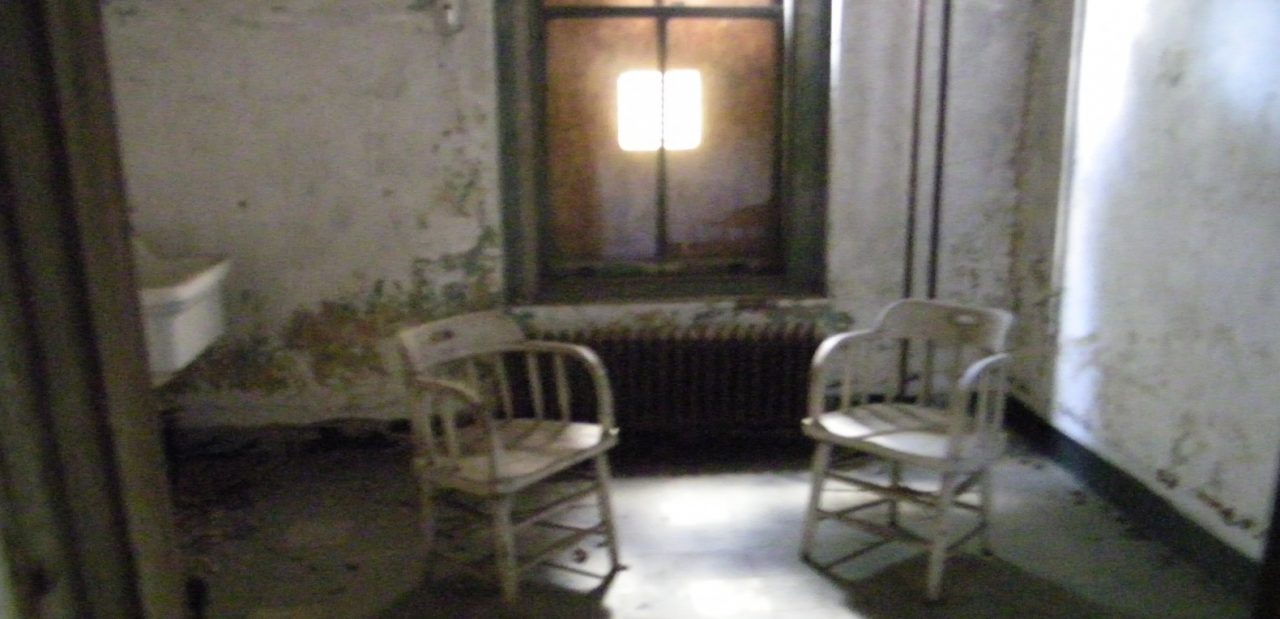We passed through security, and finally boarded the ferry with about 200 others. We disembarked on Ellis Island, entered the immigration building and found our way to the docent who would lead us on a 90 minute “backstage” tour.
We were led through a gate and into a hall, a very long hall, a hall that connected 30 hospital buildings the purpose of connecting all the buildings was to contain any contagious diseases. We were about to tour the hospital complex, and complex it is. Dave, our docent, conducted the tour walking slowly backwards. We donned hard hats while he showed us a four-foot high water mark from Hurricane Sandy.
If an immigrant didn’t pass the health test, and was contagious, they were turned back and sent back to their home country. If you had something curable, you were kept in the hospital and administered to. Meals cost .62 cents a day. Once deemed healthy, you went back to the great room for further processing. The average time for this was 4 ½ hours.
Florence Nightingales name came up. She helped design the hospital rooms. Ceiling corners and all other corners were curved. This design prevented mold and bacteria from accumulating. It is easier to disinfect curves surfaces than angular ones.
The interior and exteriors of the entire hospital are in serious disrepair. All broken windows are covered with boards that have small windows and vents to allow ventilation and light to prevent mold. Dave said the cost of renovation is in the high millions.
During the tour, we had frequent views of the Manhattan and Brooklyn skyline as well as the Verrazano Bridge, huge commercial ships, large vintage wooden sail boats, water taxies, and Staten Island Ferry. On the New Jersey side, several huge loading cranes looked like Trojan Horses and the Jersey City skyline. We passed through the Laundry Room, the Morgue, and looked into several wards. A look down a main hallway looked as it if it was a half- mile long. The light coming through a door at the far end of the main hospital was only a tiny rectangle.
We entered the reception building where immigrants were processed. Nancy wanted to find out if her grandfather came through here. She talked with the woman in charge of the American Family History Center and looked at a ships manifest to no avail. Nancy learned that she may find an answer at the archives in the Native American Museum at the Battery.
We visited the Registry Room, a huge hall with benches like the ones hundreds of immigrants waited to be processed. The original décor has been completely restored to its magnificent original state. We watched a wonderful movie with black and white stills and live action from the early 1900’s in the theatre and worked out way to the third floor to the Treasures from Home exhibit. Immigrant relatives have donated hand- me-downs that were brought to this country. I loved the astounding artifacts in these display cases: clothing, books, photographs, jewelry, and on and on. For me, I learned more world culture and history here than I ever did in school.
A room called Silent Voices had one exhibit that topped everything for me. A one minute video lf Albert Einstein arriving in Manhattan on a boat. The black and white movie, made in 1920 showed Einstein surrounded by reporters and photographers. Einstein’s frizzled hair bounced along with his smile. “What do you think of Prohibition?” a reporter asked. Einstein paused, and then quipped. “I’ll drink to that.”
I signed a guest book on the counter of the Bob Hope Memorial Library on the third floor. I quickly realized that I’ve taken my American Citizenship for granted. Back when immigrants were pouring through Ellis Island, entrants only had an idea of what it was like to be in America. When they heard stories while at home, their imaginations soared with the chance to have a better lifestyle. And here I am having it. My comment in the guestbook…”I forgot how lucky I am to be an American.”
At the information desk, I heard the phrase “Stairs of Separation.” Here was a chance to use this phrase in a poem to capture what we experienced in fewer words:
THE STAIRS OF SEPARATION
He knew.
Just off the boat,
It didn’t take him long
To fear the stairs of separation.
With all his other uncertainties
Here was another worry.
He sat on the high backed wooden bench
With hundreds of others
Waiting to be called
Above him, doctors leaned over a rail watching
They pointed to those unlucky ones
Ushered toward those stairs
A cough, a hobble, a rash
Was all it took to be taken
Out of the endless flow
For closer examination
“America welcomes those who can work
And not be a burden.” Warned a sign In six languages.
After a three thousand journey
And unimaginable hardships
His name is called
He approaches the desk
Out of the corner of his eye
He sees a mother and child
Descending the stairs
Will he be deported?
After his five hour wait
Within minutes he is approved
He will set his feet on American soil
His fears slowly dissolve.

Leave a Reply